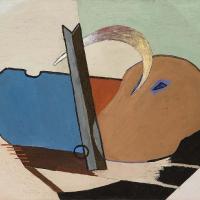A.E Gallatin
Untitled Mr17
$450.00
A.E Gallatin
Albert Eugene Gallatin wrote about, collected, exhibited, and created works of art. Called "one of the great figures in early 20th-century American culture," he was a leading proponent of nonobjective and later abstract and particularly Cubist art whose "visionary approach" in both collecting and painting left "an enduring impact on the world of modern art."
Gallatin was born in 1881 into a wealthy and socially prominent family. Showing a youthful interest in art and literature, he began to collect works by Max Beerbohm, Aubrey Beardsley, and James McNeill Whistler while still in his teens. The common element in these purchases was a preference for works that he saw as possessing a harmonious, refined, and decorative nature, rather than a naturalistic or literal one. He appreciated their aesthetic over their narrative content and their intrinsic over their didactic or utilitarian value. As he collected art, he also began to write about it. For the two decades following the turn of the century, Gallatin produced a constant stream of articles, small monographs, and books of engraved plates.
When his father died in 1902, Gallatin became head of a family consisting of himself, two sisters, and their mother. As a member of New York's social elite he gave and attended high-profile dinners, dances, weddings, and benefits. His name appeared frequently in the press as a result these activities and also as a result of his pioneering affection for automobiles and motor sport. His inheritance made it unnecessary for him to work for a living and he chose not to follow the lead of other members of his class by engaging in banking, stock brokerage, or other professional occupation. Instead, he continued to collect art and to enhance his reputation as an art connoisseur by his writings.
In the years between 1920 and 1926 Gallatin became a member of the modernist Société Anonyme and was introduced to the influential artist-critic Jacques Mauny who soon became his friend and advisor. Mauny introduced him to Pablo Picasso and other painters and to the dealer and author, Daniel-Henry Kahnweiler. These men helped further to shape his growing appreciation for cubism and Mauny, in particular, helped him revamp his collection by adding paintings by artists such as Cézanne and Picasso and selling ones that no longer suited his taste. In the mid-1920s Gallatin studied art with the artist and teacher, Robert Henri, and in 1926 produced some small still lifes and mythology-themed paintings which have been described as having "broad areas of open space broken up by clusters of oddly shaped forms." His interest in cubism deepened and he added works to his collection by Georges Braque and Juan Gris.
In 1936 Gallatin changed the name of the gallery to Museum of Living Art. By this time both the Whitney Museum and the Museum of Modern Art had opened to the public and Gallatin's museum was credited as having the collection that most interested, and influenced, young New York artists such as Arshile Gorky, Philip Guston, Robert Motherwell, and the de Koonings.
In 1938 Life Magazine profiled Gallatin and the Museum in a photo spread entitled "Albert Gallatin's Great-Grandson Sponsors a Museum of Abstract Art." The images included a caricature of Gallatin by Léger, a photo of a set of panels in the museum, major works in the collection, and copies of photographs that Gallatin had taken of prominent Parisian artists.
In 1937 Gallatin joined the American Abstract Artists group (to which Morris already belonged) and began to give it financial support. The group was formed by a loose assembly of artists to help educate the public about abstract art and to hold exhibitions. The following year, at the Georgette Passedoit Gallery in New York, he had his first solo exhibition and also sold a painting, Composition (1938), to the Museum of Modern Art. During the summer of that year he made his last trip abroad and thereafter enlarged his collection without traveling.
In 1939 he exhibited with two other members of American Abstract Artists—Morris and Charles G. Shaw—at the gallery of Jacques Seligmann in New York. Since all three were non-objective painters and all were wealthy New Yorkers, they came to be called the "Park Avenue Cubists."
During the 1940s Gallatin continued to exhibit his own paintings and organize exhibits of others. In 1942 he put together a show devoted to American women, including Morris's wife, Suzy Frelinghuysen, as well as Alice Trumbull Mason and Esphyr Slobodkina. That same year New York University informed him that he had to close the Museum of Living Art so that the space it occupied could be repurposed as a wartime economy measure. Greatly disappointed, Gallatin accepted an offer from the Philadelphia Museum of Art to provide a home for it. Within a few months 175 works from his collection were moved to Philadelphia and a few were donated to the Berkshire Museum in Pittsfield, Massachusetts, to which Morris and Frelinghuysen were connected. During the remainder of the 1940s, until his death in 1952, he continued to paint, promote, and collect non-objective art. In 1952 was given a one-man retrospective exhibition at the Rose Fried Gallery, New York. On his death he dispersed his remaining works of art to the New-York Historical Society, the Museum of the City of New York, the National Gallery of Art, and his two sisters. At the end of his life the style of painting that he had championed was falling out of favor as abstract-expressionist art achieved its first critical recognition. Since that time it has regained critical attention and public appeal and is seen at least by some as influencing the minimalist and hard-edge artists who came into prominence in the 1960s as well as younger artists such as Sarah Morris and Mai Braun.



